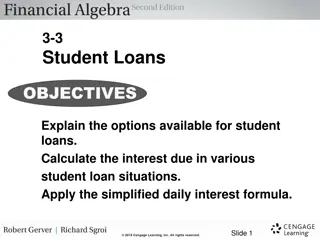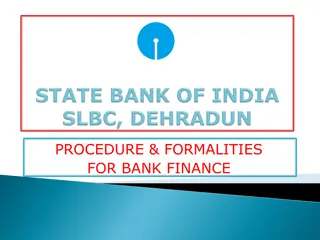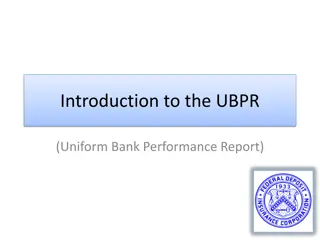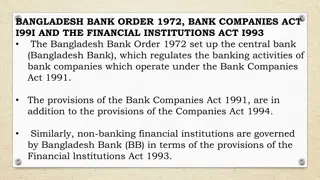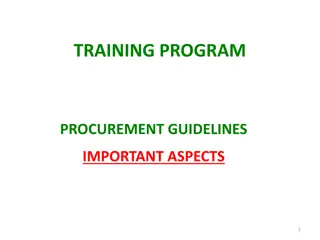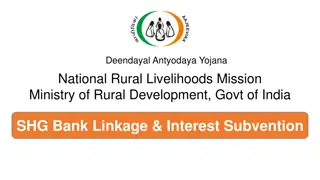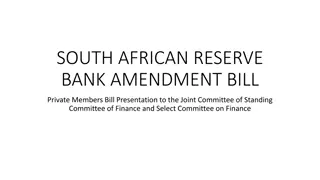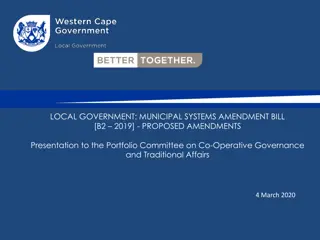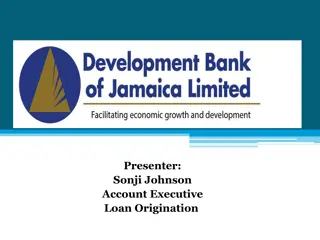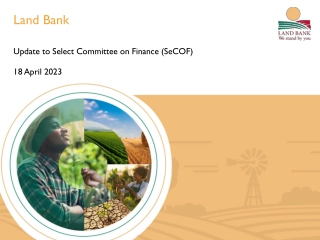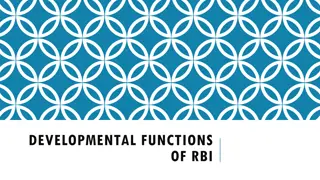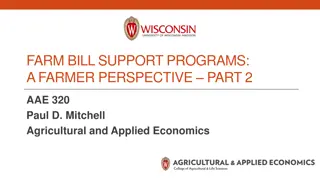Understanding Issuer Considerations for Bank Loans in Municipal Finance
Exploring the considerations and challenges faced by issuers and advisors in the realm of bank loans and securities within the municipal finance sector. The discussion covers regulatory structures, terminology, key players, and the differences in regulatory frameworks between loans and securities.
Download Presentation

Please find below an Image/Link to download the presentation.
The content on the website is provided AS IS for your information and personal use only. It may not be sold, licensed, or shared on other websites without obtaining consent from the author. Download presentation by click this link. If you encounter any issues during the download, it is possible that the publisher has removed the file from their server.
E N D
Presentation Transcript
Issuer Considerations Bank Loans Moderators: David Erdman, Capital Finance Director at Wisconsin Capital Finance Office Ellen Evans, Deputy Treasurer at Washington Treasury Office Speakers: Peg Henry, Deputy General Counsel at Stifel Financial Corp. Renee Boicourt, Managing Director at Lamont Financial Services 1
Introduction Market Volume Trends Terminology: Bank Loans, Direct Placements, Direct Purchase Offers both benefits and challenges for issuers and their advisors (MA s and Counsel) Regulatory structure is unsettled 2
Agenda for SEC Open Meeting on March 1, 2017 The [SEC] will consider whether to propose amendments to Rule 15c2-12 under the Securities Exchange Act of 1934, which would amend the list of event notices that a broker, dealer, or municipal securities dealer acting as an underwriter in a primary offering of municipal securities, must reasonably determine that an issuer or obligated person has undertaken, in a written agreement or contract for the benefit of holders of the municipal securities, to provide to the Municipal Securities Rulemaking Board. The proposed amendments would add two event notices relating to certain financial obligations incurred by issuers and obligated persons. 3
Terminology Bank Loan: A loan from a bank to a government that is not a security. Direct Purchase/Direct Placement: A security of a government purchased by a bank in a private placement. 4
The Players Bank Loan Players: Government Bank Municipal Advisor Bank Counsel Government Counsel Direct Purchase/Direct Placement Players: Government Bank or Other Investor Municipal Advisor Bond Counsel [Placement Agent] 5
Regulatory Framework - Differences Between Loans and Securities All federal and state securities laws apply to securities, but not to bank loans. Securities transactions must be reported to the MSRB, and continuing disclosure rules apply. Your financial advisor may not help you place a security under MSRB Rule G-23. Municipal advisor rules apply to advice on securities, but not bank loans. SEC rule and MSRB Rule G-42. 6
How to Distinguish a Bank Loan from a Security? In Reves v. Ernst & Young, the U.S. Supreme Court said that a loan evidenced by a note is presumed to be a security. Exceptions include: consumer financing, home mortgages, small business loans, accounts receivable, loans for ordinary operations. 7
Loan v. Security (cont.) Loans bearing a strong family resemblance to the loans on the previous slide are also not considered to be securities. Key factors in family resemblance test: motivations of the buyer and seller, plan of distribution, reasonable expectations of the investing public, and existence of alternate regulatory regime. 8
Loan v. Security (cont.) Motivations of the Buyer and Seller Financing of substantial assets indicates a security. Correcting cash-flow difficulties indicates a loan. Plan of Distribution A CUSIP indicates a note is likely to be traded and is a security. Lack of a CUSIP indicates a loan. Reasonable Expectations of the Investing Public Is the note called a bond or are loan documents used? Are loans legal under state law? Existence of Another Regulatory Scheme Federal banking regulators regulate bank loans 9
Source of Information on Loans v. Securities MSRB Notice 2011-52 (September 12, 2011). 10
Potential Benefits of Bank Loans Cost of Funds Short-term vs. long-term market Transaction Costs Disclosure Burden Voluntary EMMA Disclosure on a bank loan transaction vs. breadth of a POS for a securities transaction Challenge of accurate securities market disclosure during periods of rapidly developing credit events (budget developments, legislation, litigation) 11
Potential Benefits (cont.) Ratings Time and fees Uncertainty of rating outcome Lender s view of credit quality may be more favorable than rating Sectors and security structures subject to recent criteria changes Willingness of lender to look forward vs. back acquisition financings, e.g. Bank loan prepayment flexibility vs. call optionality, especially shorter than 10 years 12
Challenges Price discovery, ensuring competition Soliciting Interest, RFQ, RFP approaches Bundle with Underwriting RFP Control the Term Sheet Indicative pricing spread to an index vs. lender s secret sauce Role of MA and regulatory challenges MA cannot serve as Placement Agent Less delegation to MA; issuer hands-on in negotiation MA compensation structure 13
Challenges (cont.) Customary Covenants Cost pass-through for: Tax-rate changes Regulatory changes affecting bank capital reserves Relationship vs. transactional Federal Tax Reform increases risk Transferability Secondary market trading, participation Can the instrument be sold to another lender/investor? Right to pre-pay 14
Key Credit Issues Public Market Investor and Rating Agency Focus Alignment with Issuer s interests What exactly is parity debt? Mortgages, liens, title vs. public debt Remedies vs. public debtholders Acceleration, Term-out Establish at point of RFQ, solicitation of interest Issuer s term sheet - Just say no Interest rate step up as a remedy can be more benign from parity investor and issuer POV Bullet maturities, puts, rollover risk Call windows for refinancing 15
GFOA Best Practice on Understanding Bank Loans Develop policies and procedures on legal and financial aspects of using bank loans. Become familiar with various types of terms used in bank loan documents. Understand how bank loans are treated on financial statements. Understand types of disclosures made about bank loans. Assess whether state and local laws permit bank loans. Consult with financial advisors and legal counsel. 16
GFOA Best Practice (cont.) GFOA recommends asking the following questions about bank loans. Is bank qualified debt or other public debt a better solution than a bank loan? Does a bank loan apply against a government s debt capacity? How will the bank loan provider be solicited, evaluated, and selected? Is the bank loan fully amortizing or a bullet? What is the debt service structure? Are there restrictions on issuing additional debt? Does the bank loan have priority? Is the interest rate risk of variable rate debt manageable? 17
GFOA Best Practice (cont.) GFOA recommends voluntary disclosure of information about bank loans, especially if a government has other debt outstanding, using EMMA or issuer websites. loan amount and date incurred final maturity date of the loan debt service schedule interest rate method of calculation, if variable use of loan proceeds legal security and source of payment covenants, events of default, and remedies term-out provisions, payment acceleration, other non-standard terms any other important information 18
EMMA Disclosure Recent Change to MSRB s EMMA System designed for easier filing and locating of Bank Loan disclosures. 19




